How They Voted: Illinois Representatives’ Votes in Congress
Chronicle Media — July 16, 2015United States House of Representatives
 Confederate Symbols in U.S. House: The House on July 9 voted, 238 for and 176 against, to send to the Administration Committee a measure (H Res 355) requiring the removal of state flags with Confederate symbols from House areas of the U.S. Capitol complex other than members’ personal offices. Because this was a privileged resolution, there was no debate on it. Majority Leader Kevin McCarthy, R-Calif., said only that the measure “raises a number of important questions and the House is best served by committee action” on it.
Confederate Symbols in U.S. House: The House on July 9 voted, 238 for and 176 against, to send to the Administration Committee a measure (H Res 355) requiring the removal of state flags with Confederate symbols from House areas of the U.S. Capitol complex other than members’ personal offices. Because this was a privileged resolution, there was no debate on it. Majority Leader Kevin McCarthy, R-Calif., said only that the measure “raises a number of important questions and the House is best served by committee action” on it.
A yes vote was to send the measure to committee rather than vote on it immediately.
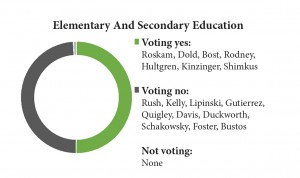 Elementary And Secondary Education: Voting 218 for and 213 against, the House on July 8 passed a GOP-drafted bill (HR 5) that would authorize $23 billion per year through 2019 for elementary and secondary education in the U.S. while diminishing federal control over how that money is to be spent. The bill would shift most funding from categorical-grant programs to a system of block grants that states and localities could spend as they see fit in keeping with federal objectives. It would allow “Title I” aid for disadvantaged districts to move with students if they transfer out of inner-city schools. The bill would continue standardized reading, math and science testing but allow local authorities to develop accountability measures based on test scores. In addition, the bill allows states and localities to set their own requirements for educating disabled students and permits resources to be shifted from failing public schools to charter and magnet schools. The bill overhauls the Elementary and Secondary Education Act of 1965 and the No Child Left Behind law of 2001.
Elementary And Secondary Education: Voting 218 for and 213 against, the House on July 8 passed a GOP-drafted bill (HR 5) that would authorize $23 billion per year through 2019 for elementary and secondary education in the U.S. while diminishing federal control over how that money is to be spent. The bill would shift most funding from categorical-grant programs to a system of block grants that states and localities could spend as they see fit in keeping with federal objectives. It would allow “Title I” aid for disadvantaged districts to move with students if they transfer out of inner-city schools. The bill would continue standardized reading, math and science testing but allow local authorities to develop accountability measures based on test scores. In addition, the bill allows states and localities to set their own requirements for educating disabled students and permits resources to be shifted from failing public schools to charter and magnet schools. The bill overhauls the Elementary and Secondary Education Act of 1965 and the No Child Left Behind law of 2001.
John Kline, R-Minn., said: “If every child is going to receive a quality education, then we need to place less faith…in the (U.S.) secretary of education and more faith in parents, teachers and state and local leaders.”
Robert Scott, D-Va., called the bill harmful to “students of color, students with disabilities and our English-language learners. It is no wonder that business groups, labor groups, civil rights, disabilities and education groups have all expressed deep concerns about this legislation.”
A yes vote was to pass the bill.
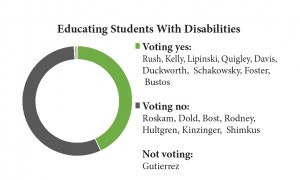 Educating Students With Disabilities: Voting 185 for 244 against, the House on July 8 defeated a bid by Democrats to guarantee adequate funding of the Individuals with Disabilities Education Act (IDEA) in HR 5 (above). That law is designed to provide disabled students with a mainstream public education in a setting that is unsecluded and with minimal restraints. Under the bill, states and localities could use block-granted federal education funds to develop their own programs for educating and accommodating disabled students in keeping with federal standards.
Educating Students With Disabilities: Voting 185 for 244 against, the House on July 8 defeated a bid by Democrats to guarantee adequate funding of the Individuals with Disabilities Education Act (IDEA) in HR 5 (above). That law is designed to provide disabled students with a mainstream public education in a setting that is unsecluded and with minimal restraints. Under the bill, states and localities could use block-granted federal education funds to develop their own programs for educating and accommodating disabled students in keeping with federal standards.
Elizabeth Esty, D-Conn., said: “Today, let’s fully fund IDEA, support special education and services for all children with disabilities and restrict the dangerous practices of seclusion and restraint.”
John Kline, R-Minn., called the motion “a procedural attempt…at the eleventh hour to derail this legislation.”
A yes vote was to fully fund IDEA as part of the education bill.
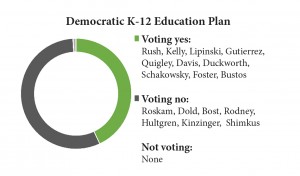 Democratic K-12 Education Plan: Voting 187 for and 244 against, the House on July 8 defeated a Democratic alternative to HR 5 (above) that sought to maintain the strong federal role in K-12 education begun by the Elementary and Secondary Education Act of 1965. The measure would re-emphasize the traditional approach of using “Title I” funds primarily to close the achievement gap between schools in inner-city and poor rural districts and those in better-off communities. It would retain No Child Left Behind testing requirements but give state and local officials authority to develop programs to improve learning and teaching weaknesses identified by test scores.
Democratic K-12 Education Plan: Voting 187 for and 244 against, the House on July 8 defeated a Democratic alternative to HR 5 (above) that sought to maintain the strong federal role in K-12 education begun by the Elementary and Secondary Education Act of 1965. The measure would re-emphasize the traditional approach of using “Title I” funds primarily to close the achievement gap between schools in inner-city and poor rural districts and those in better-off communities. It would retain No Child Left Behind testing requirements but give state and local officials authority to develop programs to improve learning and teaching weaknesses identified by test scores.
Robert Scott, D-Va., said Democrats hold “that there is a federal role in fulfilling (the Brown vs. Board of Education mandate) that all students must have access to equal educational opportunities.”
John Kline, R-Minn., said the Democratic plan “doubles down on policies we have now that are not working,” as shown by lagging achievement and high dropout rates in schools targeted by federal programs.
A yes vote was backed the Democratic plan for K-12 education.
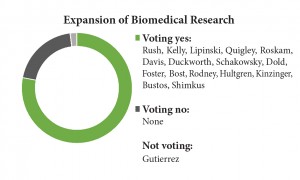 Expansion Of Biomedical Research: Voting 344 for and 77 against, the House on July 10 passed a bipartisan bill (HR 6) to increase the National Institutes of Health budget for biomedical research while speeding Food and Drug Administration procedures for bringing new drugs and medical devices to the market. The bill’s projected cost of more than $9 billion over five years would be offset by the sale of oil from the Strategic Petroleum Reserve. In addition to boosting agencies such as the NIH, FDA and Centers for Disease Control, the bill would extend the patent life of drugs that treat rare diseases or conditions while increasing Medicare payments to hospitals for antimicrobial drugs, among other provisions.
Expansion Of Biomedical Research: Voting 344 for and 77 against, the House on July 10 passed a bipartisan bill (HR 6) to increase the National Institutes of Health budget for biomedical research while speeding Food and Drug Administration procedures for bringing new drugs and medical devices to the market. The bill’s projected cost of more than $9 billion over five years would be offset by the sale of oil from the Strategic Petroleum Reserve. In addition to boosting agencies such as the NIH, FDA and Centers for Disease Control, the bill would extend the patent life of drugs that treat rare diseases or conditions while increasing Medicare payments to hospitals for antimicrobial drugs, among other provisions.
Kevin Yoder, R-Kan., said: “Each year, we spend over $700 billion on care for seniors through Medicare, yet we spend just $30 billion a year…on curing or researching the cures for every disease that plagues our country….”
Rosa DeLauro, D-Conn., said the bill would “lower standards for medical device approval at the (FDA) and create a new pathway for antibiotic approval that, in my view, involves less rigorous testing requirements…It is our duty to protect the public from potentially unsafe devices and drugs. We do not do that by reducing standards.”
A yes vote was to send the Senate a bill to spur the discovery of cures for diseases.
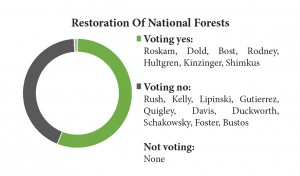 Restoration Of National Forests: Voting 262 for and 167 against, the House on July 9 passed a bipartisan bill (HR 2647) that would expedite reforestation and commercial logging activities in national forests in order to speed the restoration of acreage devastated by wildfires. The bill drew opposition over its waiving of environmental laws such as the National Environmental Policy Act and limiting one’s right to file lawsuits challenging practices such as timber salvaging in national forests. The bill makes changes to keep the U.S. Forest Service budget from being drained to meet the growing cost fighting wildfires.
Restoration Of National Forests: Voting 262 for and 167 against, the House on July 9 passed a bipartisan bill (HR 2647) that would expedite reforestation and commercial logging activities in national forests in order to speed the restoration of acreage devastated by wildfires. The bill drew opposition over its waiving of environmental laws such as the National Environmental Policy Act and limiting one’s right to file lawsuits challenging practices such as timber salvaging in national forests. The bill makes changes to keep the U.S. Forest Service budget from being drained to meet the growing cost fighting wildfires.
Bruce Westerman, R-Ark., said: “We have a problem of not salvaging timber destroyed in catastrophic events, which makes the forest more dangerous, increases future wildfire problems and makes it difficult for reforestation. This bill sets up requirements for salvage and reforestation. The Forest Service would have to implement greater reforestation in response to catastrophic events.
Niki Tsongas, D-Mass., said national forests “are a public good. Bedrock environmental laws…make sure that the public voice is heard and that critical habitats are protected not only for species that rely on our national forests and grasslands, but also for American citizens who depend on these lands for their drinking water and economic livelihoods or simply to enjoy their treasured beauty.”
A yes vote was to send the bill to the Senate.
 Limits On Lawsuits: Voting 181 for and 247 against, the House on July 9 refused to strip HR 2647 (above) of limits it would impose on lawsuits against U.S. Forest Service timber-salvaging plans that result from the bill. The bill requires plaintiffs to post bonds covering the government’s litigation expenses, which they could redeem only if they win their claim. The bill also exempts those suing the forest service from the Equal Justice Act, which enables plaintiffs to be reimbursed for attorney’s fees if they prevail in a case against the government. In addition, the bill bars courts from issuing restraining orders and preliminary injunctions against certain forest service actions authorized by the bill.
Limits On Lawsuits: Voting 181 for and 247 against, the House on July 9 refused to strip HR 2647 (above) of limits it would impose on lawsuits against U.S. Forest Service timber-salvaging plans that result from the bill. The bill requires plaintiffs to post bonds covering the government’s litigation expenses, which they could redeem only if they win their claim. The bill also exempts those suing the forest service from the Equal Justice Act, which enables plaintiffs to be reimbursed for attorney’s fees if they prevail in a case against the government. In addition, the bill bars courts from issuing restraining orders and preliminary injunctions against certain forest service actions authorized by the bill.
Niki Tsongas, D-Mass., said these limits “would prevent any plaintiffs, except those large companies with deep pockets, from bringing lawsuits against these projects, essentially keeping out the average American citizen from having their voice heard.”
Tom McClintock, R-Calif., said: “Eric Hoffer once said that every great cause becomes a movement, which becomes a business, which becomes a racket. That is what has happened with environmental litigation.”
A yes vote was to adopt the amendment.
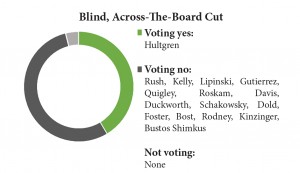 Blind, Across-The-Board Cut: Voting 168 for and 258 against, the House on July 8 defeated an amendment to inflict a 1 percent across-the-board spending cut in a bill (HR 2822) to appropriate $30.17 billion in fiscal 2016 for the Environmental Protection Agency, Department of the Interior and other agencies. Republican leaders later pulled the bill from the floor after it was amended, on a non-record vote, to bar displays of Confederate symbols at national cemeteries and other federal properties funded by the bill.
Blind, Across-The-Board Cut: Voting 168 for and 258 against, the House on July 8 defeated an amendment to inflict a 1 percent across-the-board spending cut in a bill (HR 2822) to appropriate $30.17 billion in fiscal 2016 for the Environmental Protection Agency, Department of the Interior and other agencies. Republican leaders later pulled the bill from the floor after it was amended, on a non-record vote, to bar displays of Confederate symbols at national cemeteries and other federal properties funded by the bill.
Sponsor Marsha Blackburn, R-Tenn., said: “I know that this is not a popular amendment with a lot of those who feel like…we can’t cut any more. I disagree with that.”
Ken Calvert, R-Calif., said the cut “makes no distinction between where we need to…invest in energy independence and where we need to limit spending to meet our deficit-reduction goals.”
A yes vote was to blindly cut $300 million from the bill’s discretionary-spending programs.
United States Senate
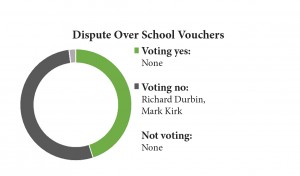 Dispute Over School Vouchers: Voting 45 for and 52 against, the Senate on July 8 refused to establish a new program in a pending K-12 education bill (S 1177) that would finance school vouchers, or scholarships, of $2,100 each for enrolling as many as 11 million low-income students in any private or parochial school of their parents’ choice. At present, the District of Columbia is the only U.S. jurisdiction where federal funds can be used to pay K-12 non-public-school tuition. This amendment sought to establish a Scholarship for Kids Act that would consume a large share of “Title I” allocations now allocated to disadvantaged public schools and students in poor communities.
Dispute Over School Vouchers: Voting 45 for and 52 against, the Senate on July 8 refused to establish a new program in a pending K-12 education bill (S 1177) that would finance school vouchers, or scholarships, of $2,100 each for enrolling as many as 11 million low-income students in any private or parochial school of their parents’ choice. At present, the District of Columbia is the only U.S. jurisdiction where federal funds can be used to pay K-12 non-public-school tuition. This amendment sought to establish a Scholarship for Kids Act that would consume a large share of “Title I” allocations now allocated to disadvantaged public schools and students in poor communities.
Lamar Alexander, R-Tenn., said: “Allowing federal dollars to follow students has been a successful strategy in American education for over 70 years. Last year, $31 billion in federal Pell grants, and $100 billion in loans, followed students to public and private colleges.”
Patty Murray, D-Wash., said “vouchers divert much-needed resources away from our public schools and reroute them to private and religious schools. Today public schools across our country, and particularly those schools with high concentrations of students in poverty, need more funding, not less.”
A yes vote was to establish a new school-voucher program for K-12 education.
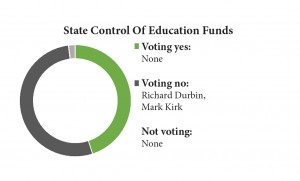 State Control Of Education Funds: Voting 44 for and 54 against, the Senate on July 9 refused to allow states to totally opt out of federal requirements for elementary and secondary education while continuing to receive their share of federal funds, which they could spend virtually as they see fit on locally designed programs for K-12 education. The amendment was offered to a bill (S 1177), still in debate, that would overhaul the Elementary and Secondary Education Act of 1965 and the No Child Left Behind law of 2001. The bill would authorize nearly $25 billion annually for K-12 education in public schools, more than half of which is “Title I” funding to benefit poor school districts and disadvantaged students.
State Control Of Education Funds: Voting 44 for and 54 against, the Senate on July 9 refused to allow states to totally opt out of federal requirements for elementary and secondary education while continuing to receive their share of federal funds, which they could spend virtually as they see fit on locally designed programs for K-12 education. The amendment was offered to a bill (S 1177), still in debate, that would overhaul the Elementary and Secondary Education Act of 1965 and the No Child Left Behind law of 2001. The bill would authorize nearly $25 billion annually for K-12 education in public schools, more than half of which is “Title I” funding to benefit poor school districts and disadvantaged students.
Mike Lee, R-Utah, said: “This amendment isn’t about states’ rights so much as it is about children’s rights….It would secure those rights by empowering America’s teachers and parents to pursue innovative policies, such as charter schools and school vouchers….”
Lamar Alexander, R-Tenn., called the amendment “a well-intentioned, unnecessary idea which won’t become law and which might help undermine the bipartisan (bill) that has a very good chance of becoming law.”
A yes vote was to adopt the amendment.
— How They Voted: Illinois Representatives’ Votes in Congress —



